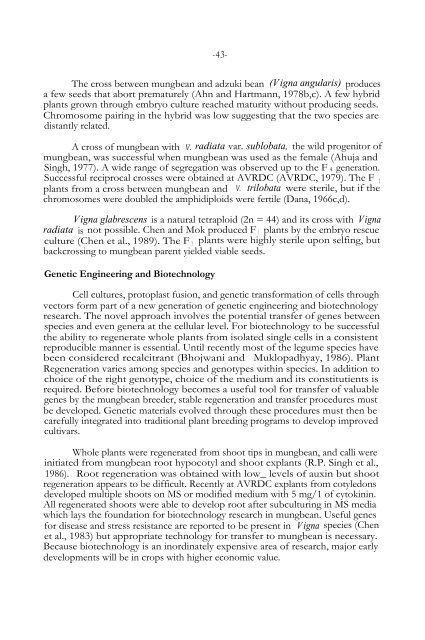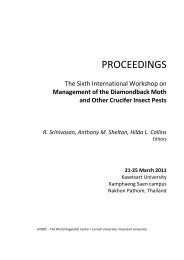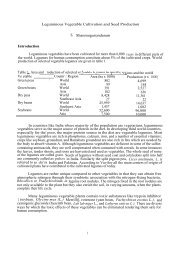MUNGBEAN VARIETAL IMPROVEMENT S. Shanmugasundaram
MUNGBEAN VARIETAL IMPROVEMENT S. Shanmugasundaram
MUNGBEAN VARIETAL IMPROVEMENT S. Shanmugasundaram
Create successful ePaper yourself
Turn your PDF publications into a flip-book with our unique Google optimized e-Paper software.
-43-<br />
The cross between mungbean and adzuki bean (Vigna angularis) produces<br />
a few seeds that abort prematurely (Ahn and Hartmann, 1978b,c). A few hybrid<br />
plants grown through embryo culture reached maturity without producing seeds.<br />
Chromosome pairing in the hybrid was low suggesting that the two species are<br />
distantly related.<br />
A cross of mungbean with V. radiata var. sublobata, the wild progenitor of<br />
mungbean, was successful when mungbean was used as the female (Ahuja and<br />
Singh, 1977). A wide range of segregation was observed up to the F 4 generation.<br />
Successful reciprocal crosses were obtained at AVRDC (AVRDC, 1979). The F 1<br />
plants from a cross between mungbean and V. trilobata were sterile, but if the<br />
chromosomes were doubled the amphidiploids were fertile (Dana, 1966c,d).<br />
Vigna glabrescens is a natural tetraploid (2n = 44) and its cross with Vigna<br />
radiata is not possible. Chen and Mok produced F 1 plants by the embryo rescue<br />
culture (Chen et al., 1989). The F 1 plants were highly sterile upon selfing, but<br />
backcrossing to mungbean parent yielded viable seeds.<br />
Genetic Engineering and Biotechnology<br />
Cell cultures, protoplast fusion, and genetic transformation of cells through<br />
vectors form part of a new generation of genetic engineering and biotechnology<br />
research. The novel approach involves the potential transfer of genes between<br />
species and even genera at the cellular level. For biotechnology to be successful<br />
the ability to regenerate whole plants from isolated single cells in a consistent<br />
reproducible manner is essential. Until recently most of the legume species have<br />
been considered recalcitrant (Bhojwani and Muklopadhyay, 1986). Plant<br />
Regeneration varies among species and genotypes within species. In addition to<br />
choice of the right genotype, choice of the medium and its constitutients is<br />
required. Before biotechnology becomes a useful tool for transfer of valuable<br />
genes by the mungbean breeder, stable regeneration and transfer procedures must<br />
be developed. Genetic materials evolved through these procedures must then be<br />
carefully integrated into traditional plant breeding programs to develop improved<br />
cultivars.<br />
Whole plants were regenerated from shoot tips in mungbean, and calli were<br />
initiated from mungbean root hypocotyl and shoot explants (R.P. Singh et al.,<br />
1986). Root regeneration was obtained with low_ levels of auxin but shoot<br />
regeneration appears to be difficult. Recently at AVRDC explants from cotyledons<br />
developed multiple shoots on MS or modified medium with 5 mg/1 of cytokinin.<br />
All regenerated shoots were able to develop root after subculturing in MS media<br />
which lays the foundation for biotechnology research in mungbean. Useful genes<br />
for disease and stress resistance are reported to be present in Vigna species (Chen<br />
et al., 1983) but appropriate technology for transfer to mungbean is necessary.<br />
Because biotechnology is an inordinately expensive area of research, major early<br />
developments will be in crops with higher economic value.

















